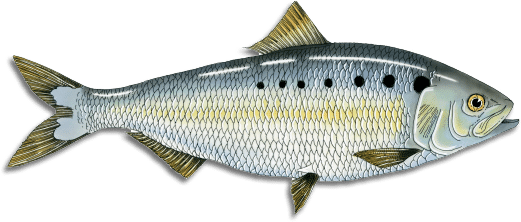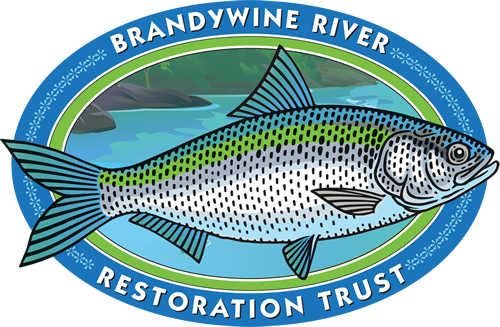The Brandywine River Restoration Trust is a cross-section of educational organizations, non-profits, governmental agencies, and private citizens whose shared goal is to restore the region’s most historic fish, the American Shad, to the Brandywine River.
The future of the once-abundant shad — often described as “the fish that fed the nation’s founders” — is in peril along the Brandywine, primarily due to eleven old industrial dams along 12 miles of the river in Delaware. It is our mission to bring back the species to the Brandywine, to swim in places they haven’t been seen in three centuries. We have already had some success … but much work remains to be done.
The Brandywine
Is one of America’s most historical and culturally significant rivers. The entire watershed measures approximately 325 square miles in southeastern Pennsylvania and northern Delaware.
The river begins as springs at over 1,000 feet in elevation on the Welsh Mountain ridge in Pennsylvania near where Chester, Berks and Lancaster counties come together. The watershed includes an east and west branch and multiple tributaries totaling several hundred stream miles.
The Delaware portion of the Brandywine River is about 15 miles long and falls about 139 feet in elevation from the state line to the mouth with the Christina River in the City of Wilmington. From there it is about one mile to the Delaware River and the fresh and salt-water mix of the “Ecological Transition Zone” of the Delaware Estuary which opens to the Atlantic Ocean between Cape May, New Jersey and Lewes, Delaware.
“The BRRT is playing an important role in restoring the free flow of the Brandywine River, reinvigorating the opportunity for shad and other aquatic life to travel up the stream to spawn, as they have for millennia …” — U.S. Senator Chris Coons (DE)
The Challenge
Creating passage for American Shad and other aquatic organizations requires that each dam be studied individually, to determine the best solution for enabling fish passage.
Alternative solutions include fish ladders, rock ramps, and dam removal among others. Each alternative is evaluated based on a multiple factors such as passage rates, historical significance, technical feasibility, public safety, environmental impact and cost.
Sometimes it is not possible to remove a dam — such as the case with Dam 2 which supplies water to the City of Wilmington, and the dams within the Hagley Museum and Library which are within a National Historic Landmark District. In these cases, an alternative method to enable fish passage is implemented.
Sediment testing above the dams revealed insignificant levels of toxins and minimal accumulation, alleviating concerns about sediment release with dam removals. Of Delaware’s eleven Brandywine River dams, one has already been removed; one of Pennsylvania’s twenty Brandywine dams has also been removed.
Experts have concluded that restoration of habitat has potential to produce significant positive impact on American shad populations. The efforts thus far have already been successful, with shad being caught in downtown Wilmington — right underneath a main east coast artery, the I-95 bridge in Delaware.
With the momentum gained, grants have been secured from the National Fish and Wildlife Foundation under the Delaware River Basin Conservation Act to restore fish passage. This will eventually reopen 24 miles of the river to spawning and allow the fish to swim up to Pennsylvania. The goal is for the shad to swim through Delaware to Pennsylvania for the first time since 1720.
American Shad

The American shad was so numerous in the Delaware Valley that the Brandywine was known as “Fishkill” by the Dutch, who noted the glistening fish stacked bank to bank.
From time immemorial, millions of shad left salty ocean waters each spring to return to the fresh water rivers where they spawned, in order to create a new generation. The mature shad came northward up the Delaware River and then upstream into one of its many tributaries: the Christina River, and then into two tributaries of the Christina — the Brandywine in Wilmington, and the White Clay Creek near Newark.
The shad run was so bountiful that the early European settlers were sustained in this new land by this abundance year after year. They valued shad not only for those they would eat as soon as they were caught, but also because shad could be dried and prepared to prevent starvation over the harsh winters. Besides its flavorful flesh, the shad’s delicious eggs, or roe, are highly nutritious, and were much valued by the founders.
Early European settlers who first came in 1638 to what is now Delaware needed to survive by milling locally-grown barley, wheat, corn, and other grains, turning them into life-sustaining bread. To power the mill wheels and turn the great mill stones, colonists built dams across the Brandywine River and the White Clay Creek.
Along the Brandywine, the earliest dam — erected by Samuel Kirk around 1720 — was built to serve his barley mill. But Kirk’s dam stretched from one side of the river to the other and halted the upstream passage of the shad at a site near today’s Adams Street in Wilmington. Shad cannot leap great heights like salmon, so almost none could clear the dam. Over time, the great historic shad runs ended, both in the Brandywine River and the White Clay Creek.


